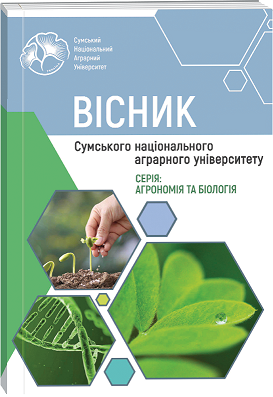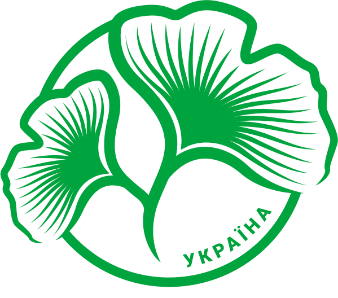CHANGES IN THE CARBOHYDRATE METABOLISM OF SCALED CARP DURING MYCOTOXICOSIS AS A BIOCHEMICAL MARKER FOR ASSESSING THE LEVEL OF TOXICITY OF THE AQUATIC ENVIRONMENT
Abstract
The article examines the effect of mycotoxicosis, in particular the effects of mycotoxin T2, on carbohydrate metabolism in scaly carp (Cyprinus carpio L.) under conditions of different concentrations of the toxin: 2 MPC, 3 MPC and 5 MPC. The aim of the work was to determine specific changes in metabolic processes caused by the action of toxicants, with an emphasis on the activity of key enzymes of gluconeogenesis, glycolysis, the Krebs cycle and the pentose phosphate pathway. Special attention is paid to the functioning of adaptation mechanisms that ensure the maintenance of energy homeostasis of fish in toxic conditions. The results of experimental studies showed that the effect of mycotoxin T2 stimulates the activity of glucose-6- phosphate dehydrogenase, which is the key enzyme of the pentose phosphate pathway. This provides an increase in the pool of pentoses, necessary for the synthesis of nucleotides, and reduced forms of coenzymes NADH+H+, which play an important role in the processes of antioxidant protection. At the same time, there is an increase in the activity of glucose- 6-phosphatase, which is an important enzyme of gluconeogenesis. This reaction is aimed at maintaining a normal level of glucose in the tissues of the body, which indicates the activation of compensatory energy supply mechanisms. Under the conditions of the highest concentration of the toxin (5 MPC), a decrease in the activity of glucose-6-phosphatase was found, which may be related to the inhibitory effect of the toxicant on the key enzymes of gluconeogenesis. Instead, there is an increase in the activity of lactate dehydrogenase, which plays an important role in the processes of anaerobic energy supply, and enzymes of the Krebs cycle, which are responsible for maintaining ATP production in fish tissues. This indicates a redistribution of metabolic pathways to ensure the body’s energy needs under stress conditions. Analysis of changes in the concentration of glucose and glycogen under the influence of different concentrations of the toxin made it possible to establish the dependence of the metabolic activity of the carp organism on the level of toxicants in the aquatic environment. It was found that the adaptive mechanisms of the body are sensitive to changes in the concentration of mycotoxins, which is important for bioindication of the state of aquatic ecosystems. In addition, it was established that changes in metabolism are specific biochemical markers that can be used to assess the level of toxicity of the aquatic environment. The obtained research results are important for ecological monitoring, as they allow to assess the state of aquatic ecosystems based on the response of hydrobionts to toxicants. Such data can be used to predict the consequences of pollution of water bodies and develop measures to reduce the negative impact of toxic substances on fish farming. The conclusions of the work contribute to the improvement of aquaculture management methods, in particular in regions with an increased level of water pollution.
References
2. Biochemica Information. (1975). Western Germany: Boehringer Mannheim GmbH. Bd. 2, 167.
3. Casey, C. A., & Anderson, P. M. (1982). Subcelluar location of glutamine synthetase and urea cycle enzymes in liver of Spiny Dogfish (Squalus acanthias). Journal of Biological Chemistry, 257(14), 8449–8453.
4. Hrubinko, V. V. (2005). Intehralna otsinka toksychnoho urazhennia biolohichnykh system. [Integral assessment of toxic damage in biological systems]. Ternopil: Naukovi zapysky TNPU. Seriia Biolohiia, 3, 111–114 (іn Ukrainian).
5. Hochachka, P.M. & Somero, G.N. (2002). Biochemical Adaptation. Oxford : Princeton University Press, 2002. 147
6. Davydov, O. N., Temnikhanov, Y. D., & Kurovskaya, L. Y. (2005). Patologiya krovi ryb [Pathology of fish blood]. Publisher, Kyiv (іn Ukrainian).
7. Koval, V. O., Mekhed, O. B., & Yakovenko, B. V. (2009). Diia toksykantiv riznoyi pryrody na vmist ketokyslot v orhanizmi koropa v period zymovoho holoduvannya [The effect of toxicants of various nature on the content of keto acids in carp during winter starvation]. Rybne Hospodarstvo, 67, 81–87 (in Ukrainian).
8. Lowry, O. H., Rosebrough, N. J., Farr, A. L., & Randall, R. J. (1951). Protein measurement with the Folin phenol reagent. Journal of Biological Chemistry, 193 (1), 265–275.
9. Martseniuk, V. M., Potrokhov, O. S. & Zinkovskiy, O. G. (2018). Energy metabolism in organs and tissues of perch Perca fluviatilis under changes of water temperature. Hydrobiological Journal, 54(4), 85–94.
10. Mekhed, O. B. (2005). Vplyv pestytsydnoho zabrudnennia vodnoho seredovyshcha na ikhtiolohichni pokaznyky ta metabolichni peretvorennia v orhanizmi koropa. [The effect of pesticide pollution of the aquatic environment on ichthyological indicators and metabolic transformations in the body of carp]. dys. kand. biol. nauk : 03.00.10. Instytut hidrobiolohii, Kyiv (in Ukrainian).
11. Mekhed, O. (2024). Сhanges in the biochemical indicators of hydrobionts in response to the toxic effect of mycotoxin T2. One World – One Health, Słupsk, 263–266.
12. Mekhed, O. B., & Yakovenko, B. V. (2003). Aktyvnist klyuchovykh fermentiv vuhlevodnoho obminu v orhanizmi koropa luskatoho v umovakh toksykozu [Activity of key carbohydrate metabolism enzymes in scaled carp under toxicosis]. Visnyk problem biolohii ta medytsyny. 6, 20–25 (in Ukrainian).
13. Mekhed, O. B., Yakovenko, B. V., & Zhidenko, A. A. (2004). Activity of some enzymes of carbohydrate metabolism in tissues of yearlings and two-years-old carps in the autumn time. Hydrobiological Journal, 40(5), 77–84.
14. Mekhed, O. B., Yakovenko, B. V., & Zhidenko, A. O. (2004). Vplyv zenkoru na vmist hlyukozy ta aktyvnist fermentiv hlyukoneohenezu v tkanynakh koropa luskatoho (Cyprinus carpio L.) pry riznykh temperaturakh [Effect of zencor on glucose content and gluconeogenesis enzyme activity in tissues of scaled carp (Cyprinus carpio L.) at different temperatures]. Ukrainskyi Biokhimichnyi Zhurnal, 76(3), 110–113 (in Ukrainian).
15. Mekhed, O. B., Zhidenko, A. O., & Yakovenko, B. V. (2005). Zminy vmistu adenilativ v tkanynakh tsoholitky i dvolitky koropa pry dii pestytsydiv [Changes in adenylate content in tissues of carp during pesticide exposure]. Ternopil: Naukovi zapysky TNPU. Seriia Biolohiia, 3 (26), 299–302 (in Ukrainian).
16. Mekhed, O. B., & Yakovenko, B. V. (2005). Vplyv pestytsydnoho zabrudnennya vodnoho seredovyshcha na vmist malatu, oksaloatsetatu, laktatu, piruvatu i aktyvnist LDH ta MDH v tkanynakh koropa [The effect of pesticide contamination of the aquatic environment on the content of malate, oxaloacetate, lactate, pyruvate, and the activity of LDH and MDH in carp tissues]. Ternopil, Naukovi zapysky TNPU. Seriia Biolohiia, 3 (26), 302–304 (in Ukrainian).
17. Mekhed, O. B., & Yakovenko, B. V. (2010). Vplyv herbitsydnoho zabrudnennya vodnoho seredovyshcha na metabolichni protsesy v tkanynakh biloho amura [The effect of herbicide contamination of the aquatic environment on metabolic processes in the tissues of grass carp]. Ternopil: Naukovi zapysky TNPU. Seriia Biolohiia, 2 (43), 353–356 (in Ukrainian).
18. National Agrarian University of Ukraine. (2004). Metodychni vkazivky z vyznachennya mikrokilkostey pestytsydiv u produktakh kharchuvannya, kormakh ta navkolyshnomu seredovyshchi [Guidelines for determining trace amounts of pesticides in food, feed, and the environment]. Kyiv (in Ukrainian).
19. Nikolaienko, T., Ivashchenko, M., Ivashchenko, N., & Mekhed, O. (2023). Adaptyvni zminy pokaznykiv krovi koropa luskatoho (Cyprinus carpio Linnaeus, 1758) yak vidpovid na zabrudnennya vody [Adaptive changes in blood indicators of scaled carp (Cyprinus carpio Linnaeus, 1758) in response to water pollution]. Natural Resources of Border Territories under Climate Change Conditions, Chernihiv, Desna-Polygraph, 99–100 (in Ukrainian).
20. Nikolаenko, T. M., Ivashchenko, M. O., Ivashchenko, N. V., & Mekhed, O. B. (2023). Biokhimichni pokaznyky krovi laboratornykh tvaryn za dii mikotoksynu T2. [Biochemical indicators of blood in laboratory animals under the influence of T-2 mycotoxin]. “Vin Smart Eco”, Vinnytsia, 276–277. (In Ukrainian).
21. Polotnianko, L., & Mekhed, O. (2023). Nakopychennya mikotoksyniv u myazakh koropa luskatoho (Cyprinus carpio Linnaeus, 1758) pry zhodovuvanni kormu, kontaminovanoho T2-toksynom [Accumulation of mycotoxins in the muscles of scaled carp (Cyprinus carpio Linnaeus, 1758) when feeding T2-toxin-contaminated feed]. Natural Resources of Border Territories under Climate Change Conditions, Chernihiv, Desna-Polygraph, 105–106 (in Ukrainian).
22. Schachman, H. K. (1959). Ultracentrifugation in biochemistry. New York: Academic Press.
23. Symonova, N. A., Mekhed, O. B., Kupchyk, O. Y., & Tretyak, O. P. (2018). Toxicants in the degradation of lipids in the organism of scaly carp. Ukrainian Journal of Ecology, 8(4), 6–10.
24. Yachna, M. H., Mekhed, O. B., Tretyak, O. P., & Yakovenko, B. V. (2019). Vmist fosfolipidiv u tkanynakh koropa luskatoho (Cyprinus carpio L.) za dii natriy laurylsulfatvmisnoho ta bezfosfatnoho syntetychnykh myyuchykh zasobiv [Content of phospholipids in tissues of scaled carp (Cyprinus carpio L.) under the influence of sodium lauryl sulfate and phosphate-free synthetic detergents]. Ternopil: Naukovi zapysky TNPU. Seriia Biolohiia, 2(76), 48–52 (in Ukrainian).
25. Yakovenko, B. V., Tretyak, O. P., Mekhed, O. B., & Ivashchenko, M. O. (2013). Zalezhnist pokaznykiv krovi koropa vid pryrody toksykanta [Dependence of carp blood indicators on the nature of the toxicant]. Ternopil: Naukovi zapysky TNPU. Seriia Biolohiia, 2(55), 29–36 (in Ukrainian).
26. Yakovenko, B. V., Tretyak, O. P., Mekhed, O. B., & Ivashchenko, M. O. (2013). Zalezhnist pokaznykiv krovi koropa vid pryrody toksykanta [Dependence of carp blood indicators on the nature of the toxicant]. Ternopil: Naukovi zapysky TNPU. Seriia Biolohiia, 2(55), 29–36 (in Ukrainian).
27. Yakovenko, B. V., Tretyak, O. P., Mekhed, O. B., Derkach, S. M., & Chkana, N. V. (2011). Aktyvnist deyakykh fermentiv u pechintsi koropa za dii herbitsydiv [Activity of some enzymes in carp liver under the influence of herbicides]. Ternopil: Naukovi zapysky TNPU. Seriia Biolohiia, 2(47), 233–236 (in Ukrainian).
28. Yatsenko, I. V., Bohatko, N. M., Bulgakova, N. V., & others. (2017). Hygiene and expertise of food hydrobionts and their processing products. Part 1. Hygiene and expertise of fishery products: A textbook. Kharkiv: Disa Plus.168 р.
29. Zhelay, M. V., Polotnianko, L. V., Yachna, M. H., Mekhed, O. B., & Tretyak, O. P. (2023). Vplyv mikotoksynu T2 na ikhtiolohichni pokaznyky koropovykh ryb [Effect of T2 mycotoxin on ichthyological indicators of cyprinid fish]. Ternopil: Naukovi zapysky TNPU. Seriia Biolohiia, 84(1), 35–40 (in Ukrainian).
30. Zhelay, M., Yachna, M., Mekhed, O., & Tretyak, O. (2023). Adaptyvni zminy ikhtiolohichnykh pokaznykiv koropovykh ryb za dii mikotoksyntu T2 [Adaptive changes in ichthyological indicators of cyprinid fish under the influence of T2 mycotoxin]. Natural Resources of Border Territories under Climate Change Conditions, Chernihiv, Desna-Polygraph, 77–78 (in Ukrainian).
31. Zhidenko, A. A., Mekhed, O. B., & Bibchuk, E. V. (2007). Zalezhnist pokaznykiv vuhlevodnoho obminu v tkanynakh karpa vid dii herbitsydiv riznoyi khimichnoyi struktury [Dependence of carbohydrate metabolism indicators in carp tissues on the action of herbicides of various chemical structures]. Biology of the 21st Century: Theory, Practice, Teaching, Kyiv: Phytosociocenter, 51–52 (in Ukrainian).

 ISSN
ISSN  ISSN
ISSN 



